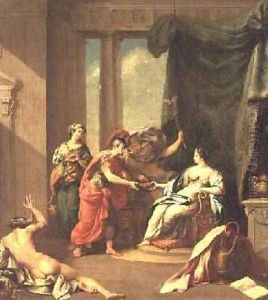Camillo Paderni Paintings
Camillo Paderni was an Italian artist and antiquarian born in 1720 in Naples, Italy, a city that was then part of the Kingdom of Naples. His exact birth date is not well-documented, but he is known to have been active during the mid-18th century. Paderni is most recognized for his role as a restorer and illustrator of ancient artifacts, particularly those that were being excavated from the Roman sites of Herculaneum and Pompeii. These sites were covered in volcanic ash and pumice after the eruption of Mount Vesuvius in AD 79, and their rediscovery in the 18th century sparked a wave of excitement and interest throughout Europe, known as the Herculaneum fever.
Paderni did not start his career as an antiquarian. Initially, he was involved in theater set designs but later shifted his focus to the study and illustration of antiquities. His career took a significant turn when he became associated with the Royal Bourbon Museum (now known as the National Archaeological Museum of Naples), where he worked under the patronage of King Charles III of Spain, who ruled over the Kingdom of Naples and Sicily at the time.
As an antiquarian and illustrator, Paderni was tasked with documenting the finds from Herculaneum and Pompeii, which included a wide array of artifacts such as frescoes, mosaics, pottery, and statues. He produced detailed drawings and engravings that were essential for the study and dissemination of knowledge about ancient Roman life and art. These illustrations were crucial for scholars who could not visit the sites themselves and served as a primary source of information on Roman art and culture for the broader European audience.
Camillo Paderni's work contributed significantly to the field of archaeology, as his careful documentation provided insight into the techniques and styles of Roman artistry. His illustrations were not only important from an academic perspective but also influenced contemporary art and aesthetics, fueling the neoclassical movement that sought to revive classical art forms and architecture.
Despite his contributions, Paderni's name is not as widely recognized as some of his contemporaries. Nonetheless, he remains a figure of importance for his role in the early stages of systematic archaeological recording. Unfortunately, details about his personal life and training are scarce, and his death in 1770 marked the end of a career that was intimately linked with one of the most exciting periods of archaeological discovery in Europe.
